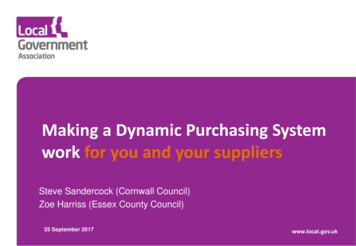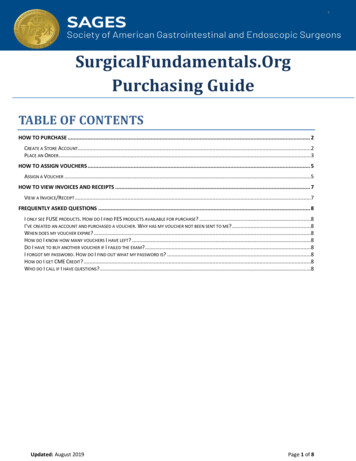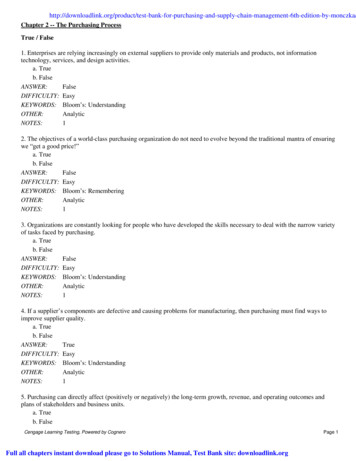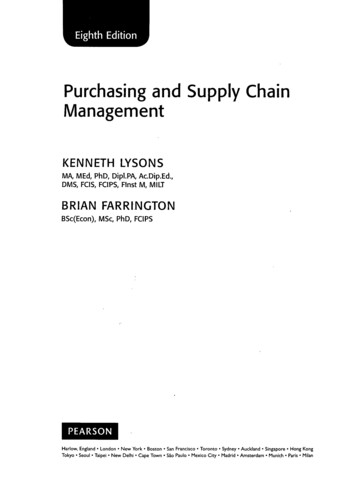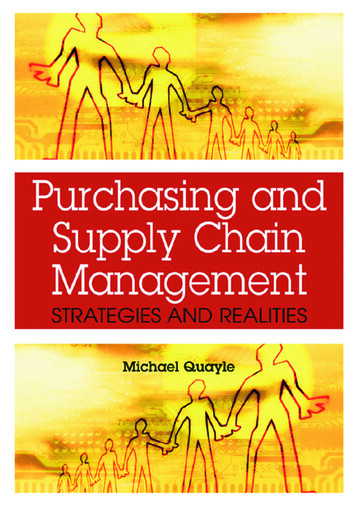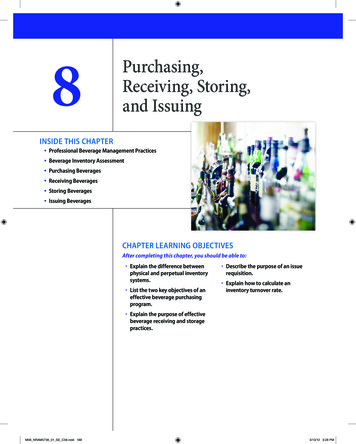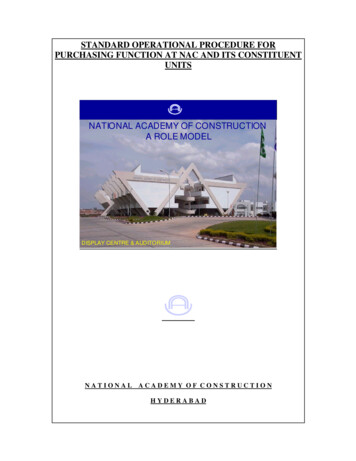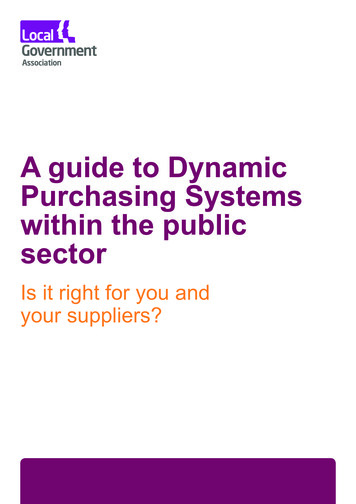
Transcription
A guide to DynamicPurchasing Systemswithin the publicsectorIs it right for you andyour suppliers?A guide to Dynamic Purchasing Systems within the public sector1
ForewordCouncils have been working together to improve theirprocurement practices and collaborative opportunitiesto improve value for money for many years now,commonly aggregating spend through frameworkagreements.A framework agreement is an ‘umbrella agreement’ thatsets out the terms (particularly relating to price, qualityand quantity) under which individual contracts (call-offs) can be madethroughout the period of the agreement (normally a maximum of four years).Unfortunately, once the umbrella agreement has been awardedthere is no opportunity for new suppliers to join until the next agreementis awarded. Dynamic (or electronic) purchasing systems (DPSs) is oneway of overcoming this barrier but until recently were only suitable forcommonly used goods and services and were time limited and inflexible.The Public Contract Regulations, updated in 2015, put forward somenew, clearer rules which do away with time limits and are flexible enoughfor suppliers meeting the tender criteria to be added to the list at anytime. It was hoped that this would allow for greater competition, howeverthe use of DPSs is still relatively low.The Local Government Association (LGA) has been working with councilsthrough its National Advisory Group for Local Government Procurementto try and understand the reasons for limited uptake of DPSs and thisdocument sets out the findings of that work, providing a number of casestudy examples and a checklist of where a DPS might be best used.I would encourage all councils to take the opportunity to review theirprocurement systems in line with the information set out in this guide toassess if using DPS arrangements provides greater opportunity beyondtraditional approaches to public sector procurement for both you andyour suppliers.Councillor Ron WoodleyDeputy Chair, LGA Improvement and Innovation Board2A guide to Dynamic Purchasing Systems within the public sector
ContentsExecutive summary4Introduction6Background7Key findings8Case studies15Cardiff Council: DPS for provision of passenger transport services16Devon County Council: DPS for passenger transport18Hampshire County Council: DPS for community transport20Nottinghamshire County Council: DPS for younger adultplacements, homebased adult social care, communitylearning, looked after children and training22Strathclyde Partnership for Transport: Communication is key22Appendices27References and other resources28Acknowledgements29A guide to Dynamic Purchasing Systems within the public sector3
Executive summaryThis guidance aims to set out practicaladvice on what to consider when decidingon whether to use a Dynamic PurchasingSystem (DPS) and what to consider whenimplementing and running such a system.The findings are a culmination of a rangeof work from a variety of public sectororganisations with either experience of, or aninterest in, utilising DPS arrangements. In making any decision to implement aDPS key stakeholders (both internally andexternally such as suppliers) should beengaged in the journey and considerations.The concept and use of DPSs is not a newone and has with the recent changes to thePublic Contract Regulations (2015) becomea more considered and used option in publicsector procurement.A survey of public sector organisationshighlighting the top four anticipated benefitsof a DPS arrangement were as follows:In considering whether or not to implementa DPS arrangement there are some keyconsiderations which should be considered,namely: Is the scale of the requirements sufficientto warrant the investment of time andresources, in particular spend beingsignificantly large (either individually or as acollaborative arrangement)? Are there large numbers of transactionswhich cannot easily be reduced throughother means such as consolidation ofinvoices, or large number of ‘independent’suppliers? Would the spend benefit from continuedconsideration of competition? Is there sufficient volatility in the markets orsectors of spend? Would the category of spend benefit inenabling and allowing access to newsuppliers to compete? It should be notedthat certain markets or sectors are bettersuited to the potential benefits of DPSarrangements than others.4The findings also highlight the importanceof considering the implementation of a DPSarrangement as a change project and assuch it should be appropriately managed andresourced. flexibility for suppliers to be added tothe DPS arrangement at any stage ofits lifetime, in other words open/ongoingaccess cost savings through increased competition opportunity to stimulate markets potential to increase access for harder toreach suppliers including small mediumenterprises.The main barriers when considering DPSsas a solution is the impact of administratinga DPS arrangement as well as the demandsof managing supplier and stakeholderengagement.The guidance sets out a number ofrecommended tips to aid both the decisionmaking on whether or not to implement a DPS,but also around implementation, these are: speak to others who have set up or operatea DPS engage with key stakeholders don’t underestimate the potential challengearound cultural changeA guide to Dynamic Purchasing Systems within the public sector
a robust business case formally signed offis considered a must consider running a pilot – trial it beforerolling out a DPS across a range ofcategories properly resource it – both implementingand also during delivery don’t forget to engage with the suppliersalong the journey, ensuring they areadequately supported during bothimplementation and delivery.A guide to Dynamic Purchasing Systems within the public sector5
IntroductionThe Local Government Association (LGA)has been working with a group of councilsand other interested public sector partnersto research the uptake and use of a DPSand the benefits and opportunities derivedfrom those who have implemented sucharrangements. This research has also helpedidentify some of the pitfalls and limitations.Within public sector procurement the conceptand use of Dynamic Purchasing System(DPS) is not a new one with the origins ofDPSs being an integral part of the originalPublic Contract Regulations of 2006.What has changed over time is how DPSarrangements can be implemented with anaim to make the options to use a DPS moreflexible than was allowed in the originalregulations, in line with the Public ContractRegulations 2015 (PCR2015).The intention of this guide is to firstly providepractical advice to councils on how to giveappropriate consideration to a DPS as aprocurement tool for particular services, andif deciding to progress with a DPS, whatconsiderations to bear in mind in order tomake it a success.It should be noted that the aim of thisguidance is not to act as an authority onapplying and implementing a DPS from alegal or regulatory perspective.Likewise, this guidance does not offer viewsaround suitability of systems or approach,only to act as a reminder that as part of theoverall decision making and supportingbusiness case consideration a view doesneed to be taken on whether to utilise existingsystem technology, procure new, or deliver viaa managed solution provided by a third party.PCR2015 now provides clearer detail onwhen and how DPS arrangements canbe used, coupled with greater flexibility,however, many public sector organisationshave still struggled to fully get to grips withimplementing DPS arrangements.6A guide to Dynamic Purchasing Systems within the public sector
BackgroundDuring 2016 representatives fromdifferent councils and other public sectororganisations in England have engaged indiscussions on their experiences of eitherconsidering the use of a DPS or implementingDPS arrangements within their respectiveorganisations. Following these discussions itbecame clear that there would be a benefitfrom sharing learning and experiences fromboth for those who had gone through such aprocess and those who had yet to do so.It was also clear that practical guidance and/or case study exemplars to help authoritiesdecide whether a DPS was a suitableprocurement option or how to implement aDPS, was also lacking or difficult to get holdof in one place.Accordingly, a virtual group from across thosepublic sector organisations was establishedwith the aim to share learning but also considerhow this shared learning could become a widerresource for others to benefit from.The work carried out by this group to helpinform this guidance included: undertaking consultation via a survey withpublic sector organisations to obtain viewson their experiences of DPS arrangements(see appendix 1) undertaking consultation via a survey withsuppliers who supply services under DPSarrangements to obtain views on theirexperiences of using DPS arrangements(see appendix 2) carrying out follow up detailed discussionswith councils to develop informed casestudies collaborating across the virtual groupto share individual experiences andknowledge exchange analysis of published contract notices onSIMAP.TED1 wider research and sharing of otherreference sources around DPSarrangements.1SIMAP.TED – http://simap.ted.europa.euThe information system for public procurement (with theFrench Acronym of ‘système d’information pour les marchéspublics’).A guide to Dynamic Purchasing Systems within the public sector7
Key findings –to implement a DPS or not?Decisions on whether to use a DPS as adelivery option is certainly one that needsto be clearly thought out prior to making anyformal commitment to do so. The intendedbenefits can be clear to list but what can bemore challenging is actually quantifying these,and selling the benefits to a wider audience.In simple terms DPS arrangements arebest suited or targeted in areas of spendwhere certain elements come together, inparticular a large volume of suppliers (with norecognised single or natural marketplace orconnection between those suppliers) coupledwith a large volume of transactions.TIPWhilst there is no single metric on whatwould constitute ‘large volumes of suppliers’or indeed ‘large volumes of transactions’ itis reasonable to expect that if the servicesrequired are to benefit from multiple suppliersthen ‘large’ would be expected to be inexcess of 20 suppliers. Below that numberother options might provide more suitablealternatives, for example the option of settingup multiple supplier frameworks. Transactionvolumes would certainly be in the hundredsand beyond per annum, with no option toconsolidate the service provided and/or limitthe resulting individual transactions.For example, in the case of CornwallCouncil the provision of taxi services isvia a DPS arrangement involving an initialenrolment of in excess of 130 independenttaxi operators with more than 1,500independent transactions per annum.From the other case studies it would appearthese figures are broadly typical acrossorganisations.8The total anticipated spend is also a keyingredient here in order to ensure that theeffort involved returns the expected benefitsfrom a DPS arrangement. Whilst there is nota defined figure in ‘what constitutes largevolumes of suppliers/transactions’ equallythere is no minimum spend per annumcriteria. However, it is worth noting that in thecase of smaller spend the effort required toimplement a DPS may not payback againstthe intended benefits.Analytical research from the capture ofdata from SIMAP.TED has indicated thatfor the sample period there were 242 liveDPS arrangements published through thesite. Average spend for top categories bynumber were: social care 72 million passenger transport (including hometo school transport) 93 million training 38 million construction 79 million.In addition, as part of the backgroundresearch from the survey to public sectororganisations, the annual spend figures forthe DPS arrangements that are set up aretypically in the millions, ranging from thelowest disclosed figure of 900,000 (andthe only figure below 1 million disclosed)to annual spend figures in excess of 100million.The inference from this is therefore thatbigger spend is a major consideration tofocus on whether or not to implement a DPS,and would certainly be advisable wherethe implementation is the first one within anorganisation.A guide to Dynamic Purchasing Systems within the public sector
Whilst overall spend is a major considerationto be had, there are other factors that needto be explored.For example, where an individual organisationdoes not have the accumulative spendthemselves, whether there is the option ofcollaborating with others.In an organisation that has a culturalacceptance around implementing DPSs,and where top spend areas have beenprogressed, there is the option to roll thisout to other smaller areas of spend.In addition to large volumes (suppliers/transactions) being a key driver towardsconsidering a DPS as a suitable delivery solution,other key characteristics are set out in Figure 1.FIGURE 1 Key characteristics of what might make consideration of a setting up a DPSa suitable delivery option – courtesy of Essex County Council ‘Making the Case toImplement a Dynamic Purchasing System’, December 2016.Large volumeof suppliersLocal bespokeoffering/localSME’sLarge volume oftransactionsLow barriersto entry forsupply marketDifficult to bulkbuy/achieveeconomies of scalePrice sensitivemarket eg fuel,location staff costsMany internal‘buyers’Opportunity toautomate elementseg contractmanagementand invoicingCapacity issues/market shapingopportunityCategory suitablefor DPSA guide to Dynamic Purchasing Systems within the public sector9
As indicated in Figure 1, and also by the useof the word ‘dynamic’ within DPS itself, thereare several ‘dynamic’ characteristics whichthe implementation of a DPS is intended tohelp offset, in particular: enabling new entrants into the marketand ultimately incl
4 A guide to Dynamic Purchasing Systems within the public sector Executive summary This guidance aims to set out practical advice on what to consider when deciding on whether to use a Dynamic Purchasing System (DPS) and what to consider when implementing and running such a system. The findings are a culmination of a rangeFile Size: 583KBPage Count: 32
